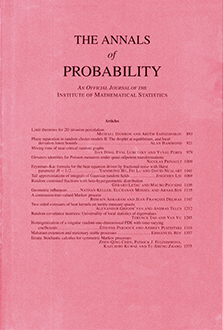Abstract
We consider the Cole–Hopf solution of the -dimensional KPZ equation started from the narrow wedge initial condition. In this article we ask how the peaks and valleys of the KPZ height function (centered by time/24) at any spatial point grow as time increases. Our first main result is about the law of iterated logarithms for the KPZ equation. As time variable t goes to ∞, we show that the limsup of the KPZ height function with the scaling by is almost surely equal to , whereas the liminf of the height function with the scaling by is almost surely equal to . Our second main result concerns with the macroscopic fractal properties of the KPZ equation. Under exponential transformation of the time variable, we show that the peaks of KPZ height function mutate from being monofractal to multifractal, a property reminiscent of a similar phenomenon in Brownian motion (Theorem 1.4 in Ann. Probab. 45 (2017) 3697–3751).
The proofs of our main results hinge on the following three key tools: (1) a multipoint composition law of the KPZ equation which can be regarded as a generalization of the two point composition law from (Proposition 2.9 in Ann. Probab. 49 (2021) 832–876), (2) the Gibbsian line ensemble techniques from (Invent. Math. 195 (2014) 441–508; Probab. Theory Related Fields 166 (2016) 67–185; Ann. Probab. 49 (2021) 832–876), and (3) the tail probabilities of the KPZ height function in short time and its spatiotemporal modulus of continuity. We advocate this last tool as one of our new and important contributions which might garner independent interest.
Funding Statement
SD’s research was partially supported by Ivan Corwin’s NSF Grant DMS-1811143 as well as the Fernholz Foundation’s “Summer Minerva Fellows” program.
Acknowledgments
We are grateful to Ivan Corwin for numerous stimulating discussions, encouragement, and giving us valuable inputs in an earlier draft of the paper. We express our gratitude toward Benjamin Landon whose suggestions helped us to improve Theorem 1.3. We thank Davar Khoshnevisan for asking interesting questions on our work. We thank Shalin Parekh and Li-Cheng Tsai for helpful conversations and discussions. We thank Yier Lin for his carefully reading and useful comments on improving the manuscript. Finally, we thank the anonymous referees for their careful reading and helpful suggestions for improvements.
Citation
Sayan Das. Promit Ghosal. "Law of iterated logarithms and fractal properties of the KPZ equation." Ann. Probab. 51 (3) 930 - 986, May 2023. https://doi.org/10.1214/22-AOP1603
Information





